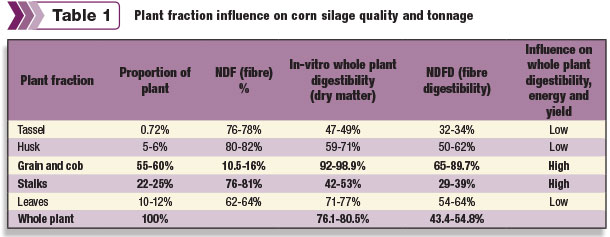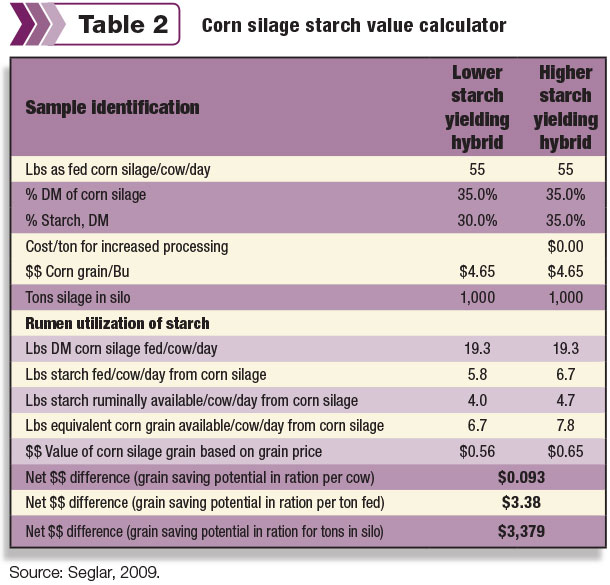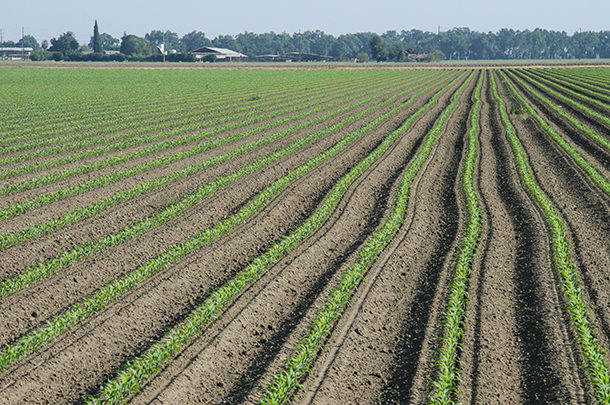Selecting the right seed for the right acre with the traits and characteristics that complement your soil conditions can improve emergence, disease and pest resistance, and provide the late-season plant health you require to achieve high tonnage for your operation.
The key to selecting the right hybrid for your operation as a dairy producer begins with understanding the significance of any data presented, and the key hybrid performance characteristics, listed in order of genetic influence and importance.
1. Grain (starch) yield: Table 1 illustrates how various parts of the plant contribute to yield and quality. As listed in the table, the grain and cob contributes 55 to 60 percent of the total yield of your corn silage crop, with more than 90 percent digestible nutrients.
 Grain yield is of highest value to achieve the milk production in your dairy herd. Dr. Joe Lauer from the University of Wisconsin found that average corn silage-designated hybrids, in comparison to hybrids focusing on leaf matter content, produced 4 percent higher starch yields.
Grain yield is of highest value to achieve the milk production in your dairy herd. Dr. Joe Lauer from the University of Wisconsin found that average corn silage-designated hybrids, in comparison to hybrids focusing on leaf matter content, produced 4 percent higher starch yields.
This 4 percent starch yield difference, shown in Table 2, can result in $3,379 reduced grain cost per 1,000 tons corn silage ensiled, assuming 35 percent dry matter and current grain pricing of $4.65 per bushel.
 More importantly, higher starch values in corn silage will allow for higher forage inclusion rates in your ration. This evidence was clearly seen in our corn silage quality in 2014, where low fibre digestibility and low starch values meant higher corn grain supplementation was the key to maintaining milk production and energy values in the ration.
More importantly, higher starch values in corn silage will allow for higher forage inclusion rates in your ration. This evidence was clearly seen in our corn silage quality in 2014, where low fibre digestibility and low starch values meant higher corn grain supplementation was the key to maintaining milk production and energy values in the ration.
Some producers have asked me why starch is more important than high sugar values in corn silage. My answer pertains to ration balancing and supplying a high-producing cow with the proper balance of nutrients:
- Starch has a more consistent rumen degradation, which helps manage rumen pH as compared to sugar, even with rations containing more grass and alfalfa silage.
- When there are maximum starch concentrations in the crop, you can be confident that there will be sufficient sugars for producing an efficient fermentation with proper packing, storage and use of a proven, efficient inoculant. Five percent sugars at harvest is the minimum value required for fermentation.
2. Tonnage (yield at 35 percent dry matter): Total tonnage is primarily a function of plant density, plant height and starch content. More than 70 percent of the tonnage and digestible energy of your corn silage crop comes from the cob and grain (49 to 53 percent total plant matter) and the stalk (22 to 25 percent of plant yield).
3. Standability: Late-season plant health provides you the flexibility to produce high-moisture corn, cob meal or grain corn if you have filled your corn silage inventory for 2015. Plant health, particularly roots, stalks and leaves, are important for two main reasons in corn silage:
- Yield potential: While yield potential is determined by the hybrid and growing conditions at the sixth leaf stage and tassel stage, leaf health is critical for starch and total yield. Leaves are critical for photosynthesis, which manufactures sugars to be converted into starch or grain in the cob.
- Moisture at harvest: While it is commonly thought that early leaf death due to plant health and frost would lower moisture, it can in fact delay your harvest by preventing moisture release. Leaves are the plant’s only mechanism for moisture evaporation during grain fill and dry-down.
Producers with leaf disease or early leaf death will find higher-than-expected plant moistures at harvest and lower starch levels, depending on the severity and pathology of leaf disease in their field.
4. Relative maturity: The general guideline for selecting a corn silage variety to maximize corn silage yield and quality is to select a variety 200 heat units above what you would select for a grain corn hybrid.
Comparing last year and this year’s growing season provides a good example of the importance of selecting a silage variety that matches the predicted growing season.
Looking at our weather data throughout eastern Canada, later-maturing hybrids that were planted last in a shortened growing season failed to meet high grain-yielding potential from a lack of heat and sunlight hours at the critical yield-determining maturity stages (sixth leaf and tassel stage).
5. Fibre digestibility (NDFd): While small NDFd differences exist among conventional silage hybrids, fibre digestibility is three times more greatly influenced by the growing conditions during vegetative growth than genetics.
Utilizing plot data from 1,403 Pioneer plot locations in Ontario, 24-hour NDFd values between a hot and dry season in 2012 versus 2014, NDFd was 3.2 percent lower in 2014.
Also interesting is that NDFd of conventional corn silage hybrids in 702 eastern Canada corn silage plots exceeded NDFd of some BMR hybrids in 2014, due to cool and wet growing temperatures in 2014.
Management techniques, such as increasing chop height at harvest (12 inches versus 6 inches) and inoculant use, can increase NDFd by 4 to 5 percent. This is equivalent to 2.2 litres more milk per cow per day or decreased feed costs, according to Dr. Kendall from the University of Wisconsin, based on research published in 2009.
Ask for adequate data
Think of comparing corn silage hybrids as you evaluate a bull by the performance of the number of daughters in your milking herd. For complete confidence, a minimum of 20 direct side-by-side comparisons (in the same plot) are recommended.
Hybrids are best compared when using hybrids with similar maturity, seed treatments, technology segment, planting population and chop height.
It is also desirable to compare hybrids in multiple locations and across several growing seasons to have a better understanding of how the hybrid will perform if exposed to extremes in growing conditions.
If comparing BMR hybrids, ask for data on direct BMR side-by-side comparisons for the most accurate agronomic data on yield performance and agronomic standability.
If BMR is a consideration, contact your agronomist and nutritionist to help decide if this is the right hybrid for you. For economic decision trees, consult your agronomist, nutritionist and seed dealer to help decide if BMR is the right fit for your operation.
Focus on the following key values when evaluating silage plot data:
1. Yield at 35 percent dry matter: This standardizes the moisture content of the hybrids in a plot to put the true yields into comparative perspective. If not standardized, one hybrid may appear higher-yielding due to having a higher moisture that is contributing to higher weights.
2. Starch percent: Higher starch is desirable. Differences can be due to hybrid performance as well as relative maturity. As dry matter decreases near maturity, starch increases 1 percent per day and sugar levels decrease as they are converted into starch. When comparing hybrids in the same trial, the less mature hybrids may have the lowest starch contents.
3. NDFd: Even though genetic differences will be small, NDFd can be compared between hybrids in a plot since they are exposed to the same growing conditions. Be sure to ask for the chop height of the plot.
4. Milk per ton and milk per acre: These are calculated index values, developed from the University of Wisconsin, to help you understand the amount of energy provided in every bite of silage (milk per ton) as well as how yield and quality combine to support your operation (milk per acre).
Milk per ton utilizes the nutritional parameters (starch yield, crude protein, neutral detergent fibre, NDFd, etc.) to calculate the potential milk that can be produced with every ton of feed removed from the field. Milk per acre is simply milk per ton multiplied by the tons per acre yield.
Depending on your farm’s situation, milk per acre may be more important if you are working with a limited land base. For farmers looking to maximize milk production and decrease ration costs, milk per ton is a good value to compare corn silage hybrids.
5. Crude protein, oil content, acid detergent fibre, neutral detergent fibre: Traits like crude protein and oil content are less instructive simply because there are minimal genetic differences among commercial hybrids.
Sugar is another trait found on some plot reports that has little reflection on genetics as plant maturity at harvest. Fibre values, such as the quantity of acid detergent fibre and neutral detergent fibre, are important in ration formulation.
However, their importance in evaluating hybrids in a silage plot is minimal because their values are simply an indication of dilution by starch and sugar.
6. Starch digestibility: Some nutritionists have requested starch digestibility values on silage plot reports. While starch digestibility is an important measurement for nutritionists switching from long-stored corn silage to new-crop silage, it is not a trait for consideration when selecting which silage genetics to plant. Significant research has proven that:
- Genetic claims to higher digestibility due to kernel and starch type have no influence on starch digestibility at corn silage maturity or full grain maturity.
- While higher moistures at harvest will see quicker increases in starch digestibility during ensiling, up to 10 percent starch can be gained between 70 percent and 60 percent moisture, as every day of additional corn silage maturity can add 1 percent higher starch (worth $1,217 per 1,000 tonnes silage).
- Proper kernel processing is the most important factor impacting starch digestibility, regardless of time in storage. Proper processing (30 percent versus 70 percent) will increase corn silage feeding value by $13,517 per 1,000 tons silage.
Seed companies dedicated to the dairy industry will be able to provide you multiple plot summaries to find the right corn silage hybrid for your cows and your fields. Collaborate with your trusted seed provider and nutritionist to fill your bunk and your milk tank in 2016. PD
References omitted due to space but are available upon request. Click here to email an editor.

-
Ashley Hall
- Dairy Specialist Western Ontario
- Dupont Pioneer
- Email Ashley Hall
PHOTO: Staff photo.









